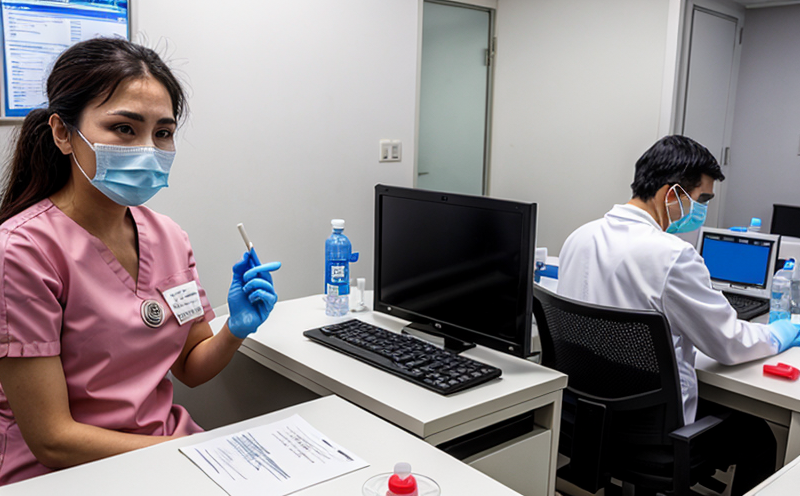Bovine Viral Diarrhea Virus (BVDV) Serology Testing in Cattle
The Bovine Viral Diarrhea Virus (BVDV) is a significant pathogen that affects cattle, causing various clinical signs and economic losses. It belongs to the family Flaviviridae, genus Pestivirus, and can lead to severe health issues if not managed effectively. Serology testing plays a crucial role in identifying BVDV antibodies in cattle, which helps in understanding herd immunity levels and informs vaccination strategies.
BVDV serology involves detecting specific antibodies against the virus through various immunoassays such as ELISA (Enzyme-Linked Immunosorbent Assay), Western blotting, or immunohistochemistry. These tests are particularly useful for identifying cattle that have been exposed to BVDV and developed immunity. The test can also differentiate between primary infections and those resulting from vaccination.
The process typically starts with the collection of blood samples from individual animals. Proper specimen handling is critical; samples must be kept cold and processed promptly to ensure accurate results. Preparing these samples involves a series of steps, including centrifugation to separate plasma or serum, which are then used for testing.
Instrumentation plays a vital role in the accuracy of serology tests. Automated ELISA machines can process multiple samples simultaneously, providing quick and reliable results. The use of advanced immunoassay techniques allows for high specificity and sensitivity, making it possible to detect even low levels of antibodies. This technology is essential for maintaining herd health and preventing the spread of BVDV.
The interpretation of test results involves comparing them against established thresholds or reference ranges. Positive serology tests indicate exposure to BVDV, while negative results suggest a lack of immunity. However, it's important to note that a single positive result does not always indicate current infection; it could reflect past exposure.
Understanding the implications of these test results is crucial for livestock management. Herd health plans can be tailored based on serology findings, ensuring targeted vaccination programs and preventing outbreaks. Regular monitoring through serology testing helps in assessing herd immunity over time and identifying potential risks early.
Why It Matters
BVDV is a zoonotic virus that poses significant threats to cattle health and productivity. The economic impact of BVDV infection includes increased veterinary costs, reduced milk yield, decreased fertility rates, and higher mortality in young calves. Effective serology testing is essential for early detection and management of the disease.
Regular monitoring through serology helps in identifying at-risk animals and implementing preventive measures such as vaccination. Vaccination plays a critical role in controlling BVDV outbreaks; however, its efficacy can vary depending on the strain present in the herd. Serology testing provides insights into which vaccines are most effective for different strains, ensuring that resources are used efficiently.
Early detection of BVDV through serology also aids in minimizing the spread of the virus within and between herds. By identifying infected animals early, farmers can isolate them to prevent further transmission. This proactive approach not only protects individual animals but also contributes to maintaining overall herd health and welfare.
Environmental and Sustainability Contributions
BVDV serology testing contributes positively to environmental sustainability by promoting responsible livestock management practices. By identifying infected or at-risk animals, farmers can make informed decisions about culling or treatment, reducing the spread of BVDV within herds.
The use of advanced immunoassay techniques in serology testing minimizes waste and resource consumption associated with less precise diagnostic methods. Automated ELISA machines provide efficient sample processing without generating significant amounts of hazardous waste. This efficiency aligns with sustainability goals by optimizing laboratory operations and reducing environmental impact.
Regular monitoring through serology helps in maintaining herd health, which indirectly supports sustainable agricultural practices. Healthy cattle are more resilient to stressors such as climate change and resource scarcity, contributing to long-term productivity and economic stability for farmers.
Competitive Advantage and Market Impact
- Innovative Technology: Utilizing advanced ELISA machines enhances the accuracy of serology tests, providing competitive advantages in disease management. Accurate results lead to more effective treatment plans, reducing recovery times.
- Economic Efficiency: Early detection and isolation of infected animals prevent outbreaks, saving on costly treatments and lost productivity due to illness.
- Certification Compliance: Reliable serology testing ensures compliance with international standards like OIE (World Organisation for Animal Health) guidelines, enhancing market access and reputation.
- Data-Driven Decision Making: Comprehensive data from regular serology tests enable evidence-based management strategies, improving herd health and productivity.
The ability to accurately detect BVDV antibodies through serology testing provides a competitive edge in the global livestock industry. Farmers who adopt this practice can demonstrate their commitment to animal welfare and sustainable practices, attracting both domestic and international clients.





